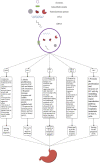Research progress on exosomal proteins as diagnostic markers of gastric cancer (review article)
- PMID: 35066729
- PMCID: PMC10224836
- DOI: 10.1007/s10238-022-00793-5
Research progress on exosomal proteins as diagnostic markers of gastric cancer (review article)
Abstract
Gastric cancer (GC) is one of the most common types of tumors and the most common cause of cancer mortality worldwide. The diagnosis of GC is critical to its prevention and treatment. Available tumor markers are the crucial step for GC diagnosis. Recent studies have shown that proteins in exosomes are potential diagnostic and prognostic markers for GC. Exosomes, secreted by cells, are cup-shaped with a diameter of 30-150 nm under the electron microscope. They are also surrounded by lipid bilayers and are widely found in various body fluids. Exosomes contain proteins, lipids and nucleic acid. The examination of exosomal proteins has the advantages of quickness, easy sampling, and low pain and cost, as compared with the routine inspection method of GC, which may lead to marked developments in GC diagnosis. This article summarized the exosomal proteins with a diagnostic and prognostic potential in GC, as well as exosomal proteins involved in GC progression.
Keywords: Diagnosis; Exosomal protein; Gastric cancer marker.
© 2022. The Author(s).
Conflict of interest statement
The authors declare that they have no competing interests.
Figures



References
Publication types
MeSH terms
Substances
Grants and funding
LinkOut - more resources
Full Text Sources
Medical
Miscellaneous

